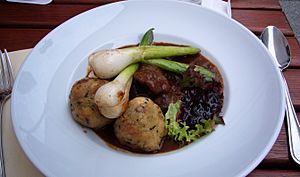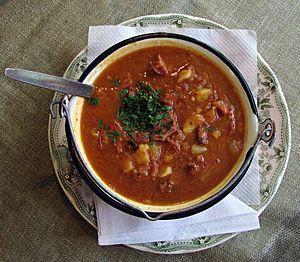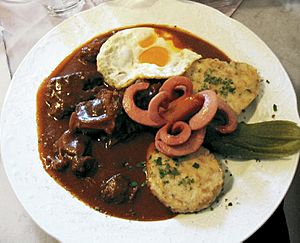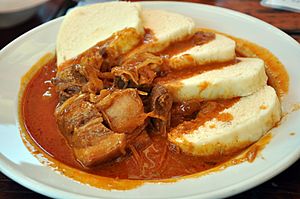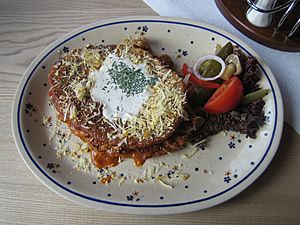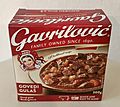Goulash facts for kids
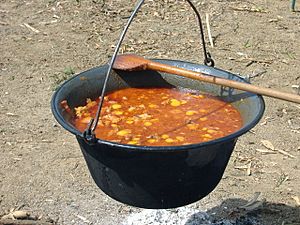
Goulash cooking in a bogrács, a traditional Hungarian cauldron
|
|
| Alternative names | Gulaš/Gulash |
|---|---|
| Type | Soup or stew |
| Place of origin | Hungary |
| Region or state | Central Europe |
| Serving temperature | Hot |
| Main ingredients | Meat, stock, noodles, vegetables (especially potatoes), paprika, spices |
Goulash (Hungarian: gulyás) is a tasty soup or stew. It is made with meat and vegetables. The dish gets its special flavor from paprika and other spices. Goulash started in Hungary and is a very popular meal in Central Europe. It is even one of the national dishes of Hungary and a symbol of the country!
This dish has a long history, going back to the 9th century. Back then, Hungarian shepherds made stews from cooked meat. They would dry the meat in the sun and pack it into bags made from sheep's stomachs. To eat it, they just needed to add water. Early versions of goulash did not have paprika. Paprika only came to Europe in the 16th century.
Contents
What's in a Name?
The name "goulash" comes from the Hungarian word gulyás. In Hungarian, gulya means 'herd of cattle'. A gulyás is a 'herdsman' or 'cowboy'.
The word gulyás first meant only 'herdsman'. Over time, the dish became known as gulyáshús. This means 'goulash meat'. It was a meat dish prepared by these herdsmen. In the Middle Ages, Hungarian herdsmen used every part of the animal. Meat was not always easy to find. So, almost all of the animal was used to make the soup.
Today, gulyás can mean both the herdsmen and the soup. For hundreds of years, the Puszta region of Hungary was home to huge herds of cattle. These cattle were driven to big markets across Europe. The herdsmen would sometimes slaughter cattle along the way. This gave them the meat for their gulyáshús.
Goulash in Hungary
In Hungary, traditional goulash dishes were thick stews. These include Gulyásleves (which means 'goulash soup'), bográcsgulyás, pörkölt, and paprikás. Cattle herders and stockmen first made these dishes.
These dishes can be made as soups or as thicker stews. You can add Garlic, caraway seeds, and wine if you like. Most Hungarian stews, except for paprikás, do not use flour or a roux to make them thick. Tomatoes are a newer addition to goulash. They were not used in the original recipes until the 20th century.
Goulash can be made with different kinds of meat. People use beef, veal, pork, or lamb. Tougher cuts of meat like the shank or shoulder are often used. These cuts have a lot of collagen. When cooked slowly, collagen turns into gelatin, which makes the goulash thick and smooth.
To make goulash, the meat is cut into chunks and seasoned with salt. Then, it's browned with sliced onion in a pot with oil. Paprika is added, along with water or stock. The goulash then simmers for a long time. Later, you can add garlic, caraway seeds, or vegetables. Common vegetables include carrots, parsley roots, peppers, and celery. Other spices like cayenne, bay leaf, and thyme can also be added. Diced potatoes are often added. They release starch as they cook, which helps make the goulash thicker. However, red peppers and potatoes were not in the original recipes. A little white wine or vinegar can be added at the end for extra flavor. Goulash is often served with small egg noodles called csipetke. The name Csipetke means 'pinch'. This is because you pinch small, fingernail-sized bits of dough to make them.
The famous Hungarian cook Karoly Gundel believed that goulash should not mix meat with grains or potatoes.
Different Kinds of Hungarian Goulash
There are many types of goulash in Hungary:
- Székely Gulyás: This version does not use potatoes. Instead, it has sauerkraut and sour cream.
- Gulyás Hungarian Plain Style: This one skips the homemade noodles (csipetke) and adds more vegetables.
- Mock Gulyás (Hamisgulyás or Fake Goulash): This uses beef bones instead of meat, plus vegetables.
- Bean Gulyás: No potatoes or caraway seeds here. It uses kidney beans instead.
- Csángó Gulyás: This adds sauerkraut instead of pasta and potatoes.
- Betyár Gulyás: This goulash is made with smoked beef or smoked pork.
- Likócsi Pork Gulyás: This uses pork and thin vermicelli noodles instead of potato and soup pasta. It's flavored with lemon juice.
- Mutton Gulyás or Birkagulyás: Made with mutton. Red wine is often added for flavor.
A thicker goulash, more like a stew, is called Székely gulyás. It was named after a Hungarian writer, József Székely.
Paprikás krumpli
"Paprikás krumpli" is a traditional potato stew. It has diced potatoes, onion, ground paprika, and some bacon or spicy sausage. It's like a goulash but uses potatoes and sausage instead of beef.
In Germany, this simple stew is called Kartoffelgulasch ("potato goulash"). It's often made with sausage.
Goulash Around the World
Thick stews, similar to pörkölt and the original cattlemen's stew, are popular in many countries. These places were once part of the Austro-Hungarian Empire. You can find them from Northeast Italy to the Carpathians. These stews are usually served with boiled or mashed potatoes, polenta, or dumplings. Sometimes, they are eaten on their own with bread. Even Romani people have their own version of goulash.
Albania
Goulash (Albanian: gullash) is a traditional dish for some people in Northern Albania.
Austria
In Vienna, Austria, a special kind of goulash was created. The Wiener Saftgulasch is a rich stew. It uses more onions but no tomatoes or other vegetables. It is usually served with dark bread. A special version is Fiakergulasch. This is served with a fried egg, fried sausage, and dumplings called Semmelknödel.
Croatia
Goulash (Croatian: gulaš) is very popular in Croatia, especially in the north. In some areas, people use venison (deer meat) or wild boar instead of beef. There is also a goulash made with porcini mushrooms. Bacon is an important ingredient in Croatian goulash.
Croatian goulash is often served with fuži (a type of pasta), njoki, polenta, or other pasta. Vegetables like green and red bell peppers and carrots are often added. Sometimes, other meats like pork or mutton are included.
Czech Republic and Slovakia
In the Czech Republic and Slovakia, goulash (Czech and Slovak: guláš) is usually made with beef. Pork versions also exist. It is served with boiled or steamed bread dumplings. In pubs, it often has fresh onion slices and is eaten with beer. Beer can even be added while cooking! You can also find goulash made with venison or wild boar. Another popular type is segedínský guláš (Székelygulyás), which has sauerkraut.
In Czech and Slovak slang, the word guláš can also mean "mishmash" or "mess." If you say mít v tom guláš, it means you are confused or don't understand something.
Ethiopia
Fish goulash (Amharic: አሣ ጉላሽ; asa gulaš) is a popular dish in Ethiopia. It is often eaten during the many fasting seasons of the Ethiopian Orthodox Church. It is usually made with a spicy sauce that has a tomato and onion base. It is served with injera (a type of flatbread) or rice.
Germany
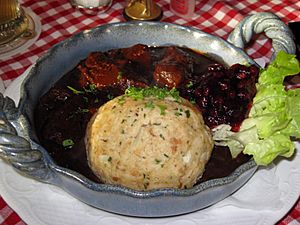
German Gulasch is a stew made from beef, pork, venison, or wild boar. It might include red wine. It is usually served with potatoes (in northern Germany), white rice, or noodles. In southern Germany, it's often served with dumplings. Gulaschsuppe (goulash soup) is the same idea but served as a soup, usually with pieces of white bread.
Italy
Goulash is eaten in parts of Italy that were once part of the Austro-Hungarian Empire. These areas include Friuli-Venezia Giulia and Trentino-Alto Adige/Südtirol. Here, it is a regular Sunday meal. It can also be found in the nearby Veneto region. A special recipe from the Pustertal (Puster Valley) in South Tyrol uses beef and red wine. It is seasoned with rosemary, red paprika, bay leaf, marjoram, and lemon zest. It's served with crusty white bread or polenta. The lemon gives it a unique flavor. Goulash is also popular in the city of Ancona.
Netherlands
In the Netherlands, goulash is usually made with beef. It is typically eaten as a stew, similar to the Hungarian pörkölt.
Poland
In Poland, goulash (Polish: gulasz) is eaten in most parts of the country. A similar dish to Hungarian pörkölt exists. It started around the 9th century. It is usually served with mashed potatoes or different kinds of noodles and dumplings, like pyzy.
Serbia
In Serbia, goulash (Serbian: гулаш) is eaten in most parts of the country. It is very popular in Vojvodina, where it was likely brought by the Hungarian people. It is a stew, similar to pörkölt. It is usually made with beef, veal, or pork. Game meats like venison and boar are also used. The main ingredients are meat and onions, usually in equal amounts, plus paprika and lard or oil. Other things like garlic, parsley, chili pepper, black pepper, cinnamon, bell peppers, carrots, tomatoes, red wine, mushrooms, and bacon can be added. Sometimes, goulash is made sweeter with tomato paste, sugar, or dark chocolate. In Serbia, goulash is most often served with macaroni or mashed potatoes.
Slovenia
In Slovenia, "partisan goulash" (partizanski golaž) was a favorite of Slovenian partisans during World War II. It is still served at large public events today. "Partisan golaž" uses equal amounts of onion and meat. Often, two or more types of meat are used. The most common goulash made at home is a thick beef stew. It is usually served with mashed potatoes. Like in other nearby regions, Szeged goulash, called segedin, is also a popular dish to make at home.
United States and Canada
North American goulash has been mentioned in cookbooks since at least 1914. It has many different recipes. It started as a dish of seasoned beef. Now, American goulash usually includes elbow macaroni, cubed steak, ground beef, or "hamburger." It also has tomatoes in some form, like canned whole tomatoes, tomato sauce, tomato soup, or tomato paste.
Images for kids
-
Goulash served in bread in a restaurant in Prague
-
A box with canned veal goulash from a Croatian company as sold in German grocery stores
See also
 In Spanish: Goulash para niños
In Spanish: Goulash para niños


